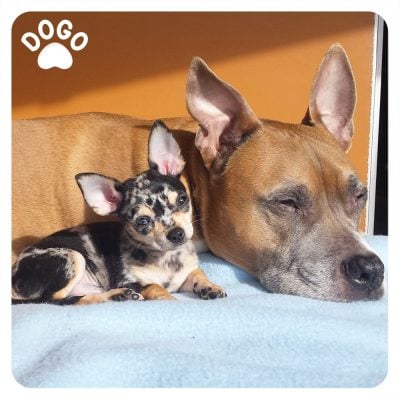So your family has grown by another 4-pawed member. Congratulations! Your puppy is probably a tornado of energy and constantly wants to play with your older dog. Yet your older dog is annoyed and has no interest in interaction. How to reconcile the extremes? Read our brief guide on how to help your young and older dog get used to each other company.
1. Focus on each dogs’ needs separately.
When a puppy comes into a home with an older dog, we want to make sure the older dog has plenty of time away from the puppy. So when they are around the puppy, they are more likely to want to interact and are less agitated or annoyed. Sometimes older dogs will tell a puppy to stop when they have had enough and they shouldn’t be punished for that.
It’s important to note that older dogs may have different play styles and preferences than puppies. Some older dogs may be more reserved and prefer to relax alone, while others may enjoy playing rough and tumble games. As a pet owner, it’s important to observe your older dog’s body language and behavior to determine their preferences. If your older dog seems uncomfortable or uninterested in playing with the puppy, it’s important to respect their boundaries and give them plenty of alone time. However, if your older dog seems open to playing with the puppy, it’s important to supervise their interactions and make sure the puppy doesn’t become too rough or overwhelming.
2. Train your puppy in a separate room, with no access to the older dog.
Make sure your puppy doesn’t have access to your older dog while you train the puppy. If you want to teach your puppy to stop being overly excited to attract your attention, don’t join them in this activity. Otherwise, they will learn that by being extra active, they earn playtime. If you cannot supervise both dogs, keep the puppy confined to a crate or separated via a baby gate.
3. Before letting the dogs interact, make the puppy tired.
Before you let your dogs meet, make sure you exercise the puppy both physically and mentally. Play a few games, take them for a walk, perform a short training session before you start. A tired puppy will have less energy to provoke their older brother.
4. Observe the puppy approaching the older dog.
Once you have a tired puppy, take them into a room with the older dog and keep the puppy on a lead. When the puppy tries to approach the older dog, say their name and ask to perform a basic command (e.g. sit, lay down). It will take their attention away from the older dog. Praise the puppy by offering lots of treats. Repeat every time your puppy gives your older dog attention.
Once your puppy seems disinterested in the older dog, let your puppy slowly approach the older dog. If the puppy behaves calmly or interacts with the older dog in a way that doesn’t upset them, praise and give plenty of praise. When taking the puppy away act happy and upbeat.
As your puppy becomes more comfortable around your older dog, it’s important to continue to supervise their interactions closely. If your puppy becomes too rough or overwhelming, it’s important to intervene and separate them before any harm is done. It’s also important to provide plenty of positive reinforcement for good behavior. When your puppy interacts calmly and appropriately with your older dog, be sure to offer plenty of praise and rewards, such as treats or toys. This will help reinforce good behavior and encourage your puppy to continue to interact positively with your older dog.
5. Keep these interactions short and sweet.
It’s important to let your dogs interact regularly – a few times a day if possible but shortly at the beginning. If your puppy is still overly excited in the way that upsets the other dog, take the puppy away and make it very boring. The puppy will learn if they are calm they will get to play with the other dog and receive tasty treats. If they aren’t – they will just be taken away with no fun.
In addition to regular interactions, it’s important to provide plenty of individual attention and playtime for both your puppy and your older dog. This will help prevent jealousy and ensure that both dogs feel loved and valued. You might consider taking your older dog for a walk or playing a game of fetch with them while your puppy is resting in another room. You could also spend some one-on-one time playing with your puppy, giving them plenty of attention and affection. By providing individual attention and playtime, you can help prevent conflicts and ensure that both dogs feel happy and fulfilled.
Make sure you always give your older dog the opportunity to walk away. The older dog needs to find the puppy fun too. Sharing treats with the older dog during this process will help and make it less stressful for the older dog.
Eventually, your puppy will change its emotional response to your older dog. The puppy will also mature as the weeks go on and not be so easily excited.
Enjoy the time with a crazy puppy and watch the transformation training can make.
[/fusion_text]



